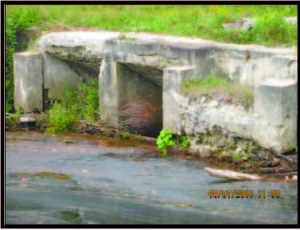Lovell ponders future fate of Mill Pond dam
 LOVELL — A group of interested residents turned out last week to what will undoubtedly be the first of several informational meetings concerning the Mill Pond Dam on Route 93 in Lovell.
LOVELL — A group of interested residents turned out last week to what will undoubtedly be the first of several informational meetings concerning the Mill Pond Dam on Route 93 in Lovell.
The dam has seen significant erosion over the years and Lovell selectman commissioned HEB Engineers of Bridgton and North Conway, N.H. to do an engineering study.
HEB Engineers was founded in 1974, and specializes in civil and structural engineering and land surveying.
Christopher Fournier, PE, the study’s author presented the findings last Tuesday at the Lovell Town House. At HEB, Fournier is the firm’s lead structural engineer and is responsible for project management, structural design and analysis of bridges and other structures, site reconnaissance, field investigation, and construction observation.
The report can be found on the town website: www.lovellmaine.us
The report outlined five options for consideration:
- Do Nothing. The documented condition of the dam has worsened significantly since the 1998 MBPC report. Concrete deterioration has continued to progress, bulging and undermining of the stone walls indicate instabilities in the overall dam structure, which had not been documented previously.
Dam failure, whether partial or a full breach is inevitable without significant construction efforts. Failure would result in the loss of Mill Pond, which would render the town’s dry hydrant useless, residential dug wells would dry up or collapse, in addition to the economic and social loss of the ponds existence. Failure would also cause rapid flow as the pond drains into the Kezar River unrestricted and could jeopardize the Route 93 bridge through scouring, for which it was likely not designed.
Cleanup efforts would be necessary, urgent, and unplanned and therefore those efforts would not be cost efficient. Permitting of a replacement dam would be unlikely as environmental agencies have a general goal of encouraging dam removal. For all of these reasons it is not recommended to Do Nothing.
- Dam Rehabilitation. Dam rehabilitation was recommended in 1998 as part of the MBPC report; however, since that time significant changes in the dam have been observed. The overall instability of the dam does not lend itself to rehabilitation efforts, since the components that are existing cannot be repaired, they need to be reconstructed or replaced and reinforced with additional structures. By definition, rehabilitation includes retaining some portions of the original built structure.
At this time, the scope of efforts needed to rehabilitate the dam cannot be considered a rehabilitation and are more in line with a reconstruction. It is not recommended that the dam be rehabilitated.
- Dam Reconstruction. This alternative includes the careful deconstruction and complete reconstruction of the dam from its foundation. The goal of this alternative would be to reuse salvaged materials (granite blocks and suitable fill) to completely rebuild the dam as a reflection of its current state. A modern dam structure would be constructed and concealed to look like the existing dam, and minimal modifications to the spillway configuration could be made.
Considerations for improving public safety and encouraging recreational use of the dam site could easily be incorporated in this alternative. This alternative should only be considered if the aesthetics of the current dam are of significant historical or cultural significance. It is important to realize that the reconstruction of the dam will significantly change its appearance. Because the dam characteristics are not all from the original construction and the resulting composition of the dam is not exceptional, it is likely that this alternative will not be pursued. It is not recommended that the dam be reconstructed in-kind.
Estimated cost: $1.2 million (note: engineer’s opinion of probable costs are presented for the proposed alternatives. These costs include a 20% contingency, engineering design fees, and construction administration fees).
- New Dam Construction. This alternative includes the complete demolition and construction of a new dam utilizing modern techniques. The existing dam has remnants of its previous use as a mill and reconfiguration during improvements in 1915.
The goal of this alternative would be to provide an efficient new structure designed and constructed to current standards with a focus of ease of maintenance and operation. Incorporation of a fish ladder system could be implemented into this alternative if desired by the town or recommended by regulatory agencies.
Considerations for improving public safety and encouraging recreational use of the dam site are easily incorporated in this alternative. A minor pedestrian bridge is proposed to span the spillways and preserve pedestrian access at the site.
Based on the 2009 report, hydroelectric generation was not feasible when rates were in the range of $0.09 per kW. At this time, according to the Maine Public Utilities Commission, Central Maine Power rates for residential and small commercial customers are near $0.07 per kW. The hydroelectric report recommended reevaluating the potential if rates rose to $0.20 per kW.
Because of the long lifetime of new dams, in the range of 100 years, and the unknown course of future energy pricing, considerations should be made to accommodate future hydroelectric capabilities, but investing in the infrastructure for hydroelectric at this time is not feasible or recommended. It is recommended that the dam be replaced.
Estimated cost: $950,000.
- Partial Dam Removal. This alternative includes the partial deconstruction of the upper part of the dam. Specifically, the bridge and concrete spillway structures would be removed and upper stonework disassembled and reused to configure falls at the downstream end of the existing dam. Careful drawdown of the pond would ultimately result in a much lower pond elevation or the reestablishment of the Kezar River upstream of the dam location. Efforts to provide supplemental scour protection of the Route 93 bridge abutments may be needed since the bridge was designed to exist over stagnant water and the partial dam removal would result in a flowing water condition.
The future desire to restore a dam at the site would be unlikely based on the current natural resource agency climate. Based on the town’s desire to maintain Mill Pond, it is not recommended that the dam be partially removed.
Estimated cost: $400,000.
- Full Dam Removal. This alternative is similar to the partial dam removal, but the scope includes the complete removal of the dam structure including all concrete and stone. The goal of this alternative is to restore the site as the channel of the Kezar River. This scope of work would need to be closely coordinated with the Maine Department of Transportation to not jeopardize the Route 93 bridge. Significant channel restoration downstream would be performed to accommodate a natural elevation change starting upstream near the bridge site.
Again, based on the town’s desire to maintain Mill Pond, it is not recommended that the dam be fully removed.
Estimated cost: $550,000.
Recommendation
After reviewing the alternates with respect to environmental impact, cost-efficiency, constructability, and aesthetics, maintaining Mill Pond for recreation, fire protection, water supply and economics in a cost effective manner was the main driver for the recommended alternative to construct a new dam (Alternative D, $950,000).
Alternative C could meet these requirements, but it is not cost effective.
Alternatives A, E and F all result in Mill Pond being eliminated and therefore are not recommended.
More discussion on the issue is expected in the coming months.

